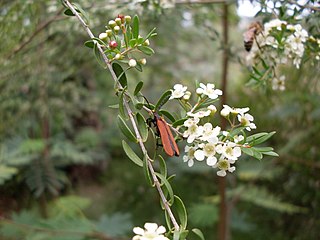
Thomasia tenuivestita is a species of flowering plant in the family Malvaceae and is endemic to the south-west of Western Australia. It is a shrub with its new growth covered with greyish, star-shaped hairs, and has egg-shaped leaves, and racemes of mauve flowers.

Eremophila divaricata, also known as spreading emu bush, is a flowering plant in the figwort family, Scrophulariaceae and is endemic to Australia. It is a shrub with stiff, spreading, tangled branches which are often spiny on their ends, erect leaves and mauve to lilac-coloured flowers.

Howittia is a genus of plant containing the single species, Howittia trilocularis, commonly known as blue howittia, and is endemic to Australia. It is a tall shrub found growing in shaded valleys and on rainforest edges, it has hairy leaves and single, purple flowers.

Prostanthera melissifolia, commonly known as balm mint bush, is a species of flowering plant in the family Lamiaceae and is endemic to south-eastern Australia. It is an erect shrub with hairy branches, egg-shaped leaves with fine teeth on the edges and mauve to purple or pink flowers on the ends of branchlets.

Lasiopetalum behrii, commonly known as the pink velvet bush, is a species of flowering plant in the family Malvaceae and is endemic to southern continental Australia. It is an erect shrub with lance-shaped, narrowly oblong to narrowly elliptic leaves and groups of white to pink and reddish-brown flowers.

Kunzea peduncularis, commonly known as mountain burgan, is a flowering plant in Myrtaceae, the myrtle family, and is endemic to Victoria, Australia. It is usually a dense shrub and has lance-shaped to egg-shaped leaves with the narrower end towards the base. Dense groups of white flowers appear in early summer.

Trochocarpa clarkei, commonly known as lilac berry, is a species of flowering plant in the family Ericaceae. It is a dense, often low-lying shrub with oblong leaves and bisexual flowers arrange in dense flowering spikes, usually on old wood, with maroon and green petals joined at the base to from an urn-shaped to bell-shaped tube with dense tufts of hairs in the throat. The fruit is a bluish-purple drupe.

Boronia algida, commonly known as alpine boronia, is a flowering plant in the citrus family, Rutaceae and is endemic to south-eastern Australia. It is an erect shrub with many branches, pinnate leaves and white to bright pink, four-petalled flowers usually borne singly on the ends of branches.

Sannantha pluriflora, commonly known as tall baeckea, is a species of flowering plant in the myrtle family, Myrtaceae, and is endemic to continental southeastern Australia. It is a shrub or small tree with lance-shaped to elliptic leaves, and groups of two to nine white flowers arranged in umbels in leaf axils.

Seringia nephrosperma, commonly known as free-carpel fire-bush, is a species of flowering plant in the mallow family and is endemic to northern Australia. It is an upright, suckering shrub with hairy new growth, usually oblong to lance-shaped leaves, and purple flowers arranged in groups of 5 to 25.

Seringia hillii is a species of flowering plant in the mallow family and is endemic to eastern Australia. It is a single-stemmed shrub with hairy new growth, egg-shaped leaves and usually mauve flowers arranged in groups of 2 to 9.

Seringia hermanniifolia, commonly known as crinkle-leaved firebush, is a species of flowering plant in the mallow family and is endemic to the south-west of Western Australia. It is a low-growing or prostrate, suckering shrub with hairy new growth, hairy, wavy, oblong to egg-shaped leaves and mauve to bluish flowers arranged in groups of 3 to 8.

Seringia velutina, commonly known as velvet firebush, is a species of flowering plant in the family Malvaceae family and is endemic to the south-west of Western Australia. It is a suckering shrub that sometimes forms dense colonies. Its leaves are narrowly elliptic to egg-shaped and it has 3 to 11 pale pink to purple flowers arranged in loose cymes.

Thomasia angustifolia, commonly known as narrow-leaved thomasia, is a species of flowering plant in the family Malvaceae and is endemic to the south-west of Western Australia. It has densely hairy young stems, narrowly oblong, wrinkled leaves and pinkish-purple, bell-shaped flowers.

Commersonia craurophylla, commonly known as brittle leaved rulingia, is a species of flowering plant in the family Malvaceae and endemic to southern continental Australia. It is a dense, spreading shrub with crinkled, narrowly oblong to linear leaves, and white to cream-coloured flowers.

Pultenaea canaliculata, commonly known as coast bush-pea, is a species of flowering plant in the family Fabaceae and is endemic to coastal areas of southern continental Australia. It is a rigid, spreading shrub with hairy, cylindrical leaves, and yellow and crimson flowers.
Bossiaea distichoclada is a species of flowering plant in the family Fabaceae and is endemic to south-eastern continental Australia. It is an erect shrub with hairy branches, kidney-shaped to more or less round or heart-shaped leaves with the narrower end towards the base, and uniformly bright yellow flowers.

Thomasia cognata is a species of flowering plant in the family Malvaceae and is endemic to the south-west of Western Australia. It is a compact, multi-stemmed shrub with wrinkled, narrowly oblong to elliptic leaves and pale pink flowers.

Thomasia rugosa, commonly known as wrinkled leaf thomasia, is a species of flowering plant in the family Malvaceae and is endemic to the south-west of Western Australia. It has wrinkled, lance-shaped to egg-shaped leaves with wavy edges, and pink to mauve flowers.

Commersonia magniflora is a species of flowering plant in the family Malvaceae and endemic to Australia. It is an erect shrub with wrinkled, narrowly oblong to elliptic or egg-shaped leaves, and deep pink flowers.




















